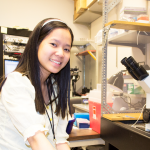Education
- Dr. rer. nat. Biochemistry, Freie Universität Berlin, Germany
- M.Sc. Medical Neurosciences, Charité Universitätsmedizin Berlin, Germany
Short Biography
I am interested in the molecular machinery that underlies synaptic structure and function and that enables synaptic plasticity and remodeling.
During my thesis work, I investigated the synaptic scaffold protein MPP2 of the family of membrane-associated guanylate cyclases (MAGUKs) and its function at the periphery of the postsynaptic density of excitatory synapses where it interacts with several proteins mainly associated with inhibitory signalling.
In my postdoctoral training in the Nedivi lab, I will investigate the molecular composition of inhibitory synapses depending on their positioning, afferents and dynamic history. I hope to contribute to our understanding of how the heterogeneity in the synaptic protein framework affects synapse maturation and plasticity.
Publications
- JNK activity modulates postsynaptic scaffold protein SAP102 and kainate receptor dynamics in dendritic spines.
Kunde SA, Schmerl B, von Sivers J, Ahmadyar E, Gupta T, Rademacher N, Zieger HL, Shoichet SA.
J Biol Chem. 2024 May;300(5):107263 - Sub-membrane actin rings compartmentalize the plasma membrane.
Rentsch J, Bandstra S, Sezen B, Sigrist P, Bottanelli F, Schmerl B, Shoichet S, Noé F, Sadeghi M, Ewers H.
J Cell Biol. 2024 Apr 1;223(4) - The synaptic scaffold protein MPP2 interacts with GABAA receptors at the periphery of the postsynaptic density of glutamatergic synapses.
Schmerl B, Gimber N, Kuropka B, Rentsch J, Kunde S-A, Ewers H, Freund C, Schmoranzer J, Rademacher N*, Shoichet SA*.
PLoS Biology. 2022; 20(3):e3001503. - Disease-associated scaffold protein CNK2 modulates PSD size and influences trafficking of new synaptic binding partner TNIK.
Zieger H, Kunde S-A, Rademacher N, Schmerl B, Shoichet SA.
Scientific Reports. 2020; 10(1):5709. - MPP2 is a postsynaptic MAGUK scaffold protein that links SynCAM1 cell adhesion molecules to core components of the postsynaptic density.
Rademacher N*, Schmerl B*, Lardong JA, Wahl MC, Shoichet SA. Scientific Reports. 2016; 19;6:35283. - Influence of Pigment Epithelium-Derived Factor on Outcome after Cerebral Ischemia in the Striatum in the Mouse.
Zille M, Riabinska A, Terzi MY, Balkaya M, Schmerl B, Endres M, Vajkoczy P, Pina AL. PLoS One. 2014; 3;9(12):e114595.



